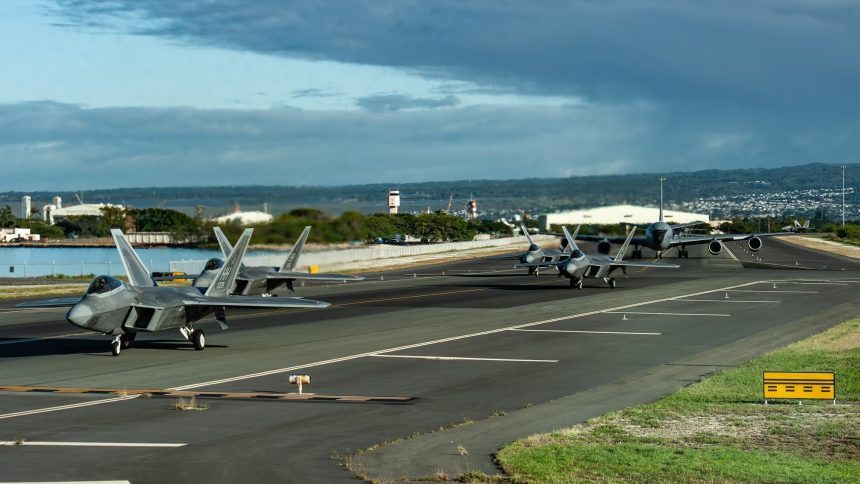Sentry Aloha 25-1 saw for the first time a team of Battle Management Operators relaying data aboard a KC-135 and rapidly deployable Tactical Operations Center-Lite advanced airspace tactical control system.
The Hawaii Air National Guard’s (HIANG) 154th Wing concluded on Feb. 12, 2025 its long running defense readiness exercise, Sentry Aloha, at Joint Base Pearl Harbor-Hickam, Hawaii. The exercise started on Jan. 29 and involved nearly 30 aircraft and about 800 joint personnel.
The 20-year-old exercise saw a series of firsts during its Sentry Aloha 25-1 edition. In fact, the 169th Air Defense Squadron provided a team of Battle Management Operators aboard the KC-135 Stratotanker for the first time, and a TOC-L (Tactical Operations Center-Lite) was used as a compact, easily deployable, advanced airspace tactical control system.
Interestingly, the U.S. Air Forces in Europe-Africa (USAFE-AFAFRICA) also revealed on Feb. 20, 2025 the deployment of the TOC-L from Aviano Air Base in Italy to the Combined Task Force-Horn of Africa in Nov. 2024. This was the ffirst time that the system was used in a deployed environment, stated the command.
The HIANG’s 154 WG concluded Sentry Aloha 25-1 on 2.12.25 bringing together joint military participants to conduct large-scale training operations throughout the Hawaiian Islands. https://t.co/Ig3AnnjnWK#HIANG #MCBH #DOD #readiness #interoperability #missioncapabilities pic.twitter.com/4wf7zwUOAu
— Joint Base Pearl Harbor-Hickam (@JointBasePHH) February 14, 2025
Sentry Aloha 25-1
Sentry Aloha 25-1 saw the participation of at least five F-22A Raptors, based on the images released on the DVIDS network, assigned to the 199th Fighter Squadron (FS) at Hickam AFB, Hawaii. Other guest participants included KC-135 Stratotankers from the 203rd Air Refuelling Squadron (ARS), and three F-35C Lightning IIs assigned to the Air Test and Evaluation Squadron (VX-9) at Edwards AFB, California, that arrived on Jan. 21, 2025.
Agile Combat Employment (ACE) was a major element of the exercise. Operations took place across Joint-Base Pearl Harbor Hickam, the Pacific Missile Range Facility (PMRF) on the island of Kauai, and Kaneohe Marine Corps Base on Oahu.
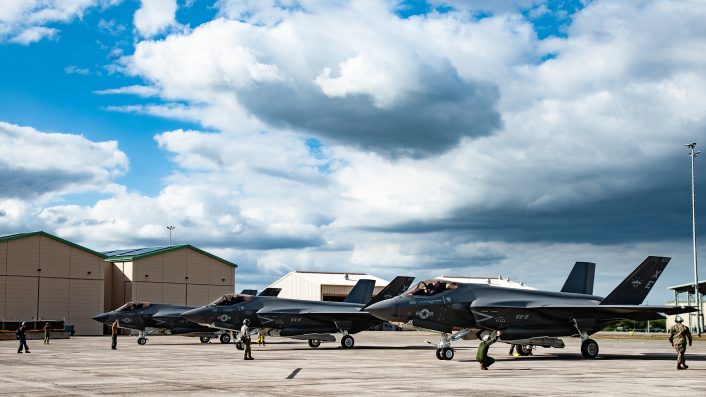
Roughly 800 joint personnel including Guardsman, Reservists, local active duty partners from the 15th Wing, Sailors and Marines and nearly 30 aircraft from six states participated, according to the Air Force. The aircraft flew a total of 182 sorties, logging well over 300 flight hours, and marking a new chapter in “interoperability among participating units,” said the service.
The Air Force also coordinated with the FAA (Federal Aviation Authority) for “safe and secured flying operations while minimizing impact on local air traffic.” Units are now looking forward to the second phase of the exercise, expected to be held in the first half of the year.
A press release said that the latest installment of the exercise enabled “tailored, cost effective and realistic combat training for Air National Guard, U.S. Air Force, and other Department of Defense services” while providing “skill sets necessary to perform homeland defense and overseas combat missions.”
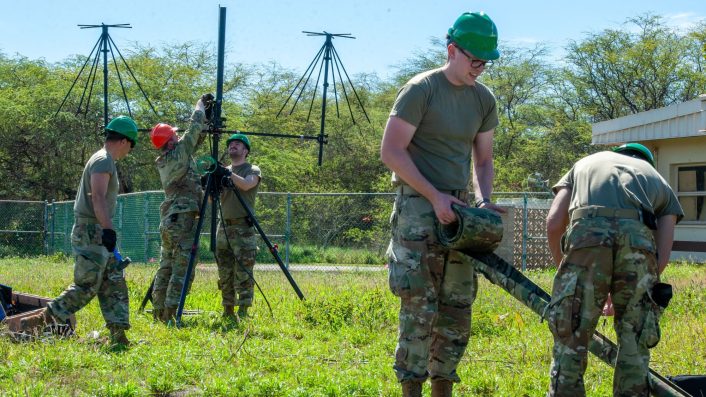
TOC-L communications
Among the ACE concepts that were deployed and rehearsed across the Hawaiian Islands was the use of the TOC-L (Tactical Operations Center-Lite) of the Connecticut Air National Guard’s 103rd Air Control Squadron. The TOC-L is described as a “compact and ready for rapid deployment and advanced airspace tactical control.”
The system eliminates the use of “extensive infrastructure and staffing” by incorporating “cloud-based command and control capabilities, enabling seamless operations worldwide.” It can be packed into about two dozen hand-carried cases and be operational within an hour with minimal personnel.
Calling it their “most ambitious TOC-L execution to date,” Maj. J. Seth Bopp, the 103rd ACS director of operations, said they had months of planning and experience from other exercises like Agile Panda, Nimble Cheetah, Mobile Marlin and Sentry Savannah. At Sentry Aloha 25-1, they did it “faster and did it with more sites,” and with help from the U.S. Marine Corps and U.S. Space Force.
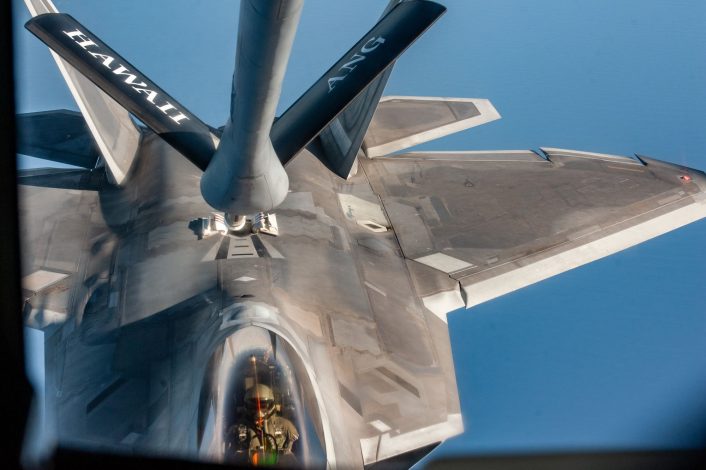
For instance, the 103rd ACS disassembled the TOC-L equipment from Kaneohe Marine Corps Base on Oahu, deployed from there on a KC-130J Hercules to the Pacific Missile Range Facility on the neighboring island of Kauai, conducted operations “and re-deployed back to Oahu,” all within five hours. A photo caption of the TOC-L being deployed at the PMRF described it as “a mobile battle management system that allows for decentralized teams to control airspace.”
“Doing all of that in a short window across two islands was paramount in proving ACE concepts for TOC-L,” said Senior Master Sgt. Jonathan Burr, 103rd Air Control Squadron senior enlisted leader. “Traveling out from our home base in Connecticut and across the Hawaiian Islands, the team had to jump through hoops to make things happen and they were exceptional.”
TOC-L in Agile Combat Employment
At MCAS Kaneohe Bay on Feb. 6, the 103rd ACS also transferred the cloud-based radar and radio connection component of the TOC-L to a USMC KC-130J Hercules, which presumably reached the PCMR the same day. Over a two-week span, the 103rd ACS trained and tested the system at three locations across two islands, and ended the exercise with four locations across three islands.
It was the first time a unit was able to remote in two radio sites, said the statement. “The 103rd definitely showed up ready to work and utilize their TOC-L system to kind of be the highlights, it’s definitely something new and different that we haven’t really done before.” said Ohman.
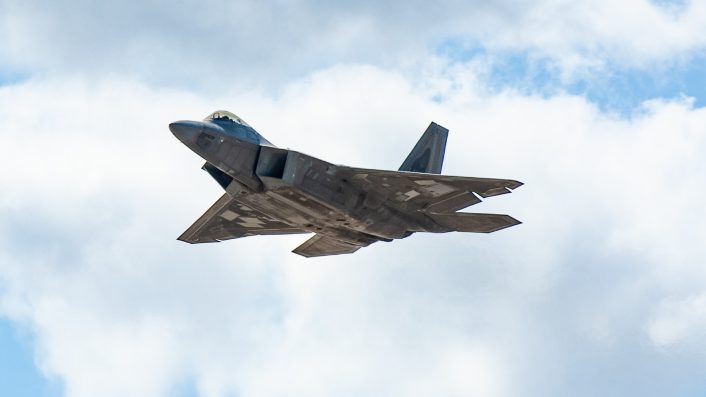
In the operation to transfer the TOC-L from Italy’s Aviano Air Base to CJTF-HOA at Camp Lemonnier in Djibouti in Nov. 2024, the USAFE described the TOC-L as a “new command-and-control node designed to be rapidly deployable and maneuverable,” helping battle management teams and sensor operators build a “common operation tactical air picture” to assist with safe coordination between civilian and friendly military aircraft.
The system can ingest information from friendly host nation radars, improving “operational resilience and flexibility, creating dilemmas for adversaries.” A defining feature is the “the ability to fit into the Air Force’s Agile Combat Employment initiative.”
This was also seen in Sentry Aloha 25-1. The TOC-L, though not light, can be moved and transported with ease. “TOC-L is a big difference, it’s a game changer,” said Senior Airman Appolonia Meynisse, 606 ACS network operations technician. “It’s more compute, more compact, more scalable, flexible and easy to use.”
Dynamic ACE
Sentry Aloha is built around Dissimilar Air Combat Training (DACT), where pilots engage in combat scenarios against “aircraft with different performance capabilities,” rather than against identical airframes.” This allows pilots to adapt to “unpredictable engagements,” which sharpens their ability to “exploit their own platform’s strengths while capitalizing on adversary weaknesses.”
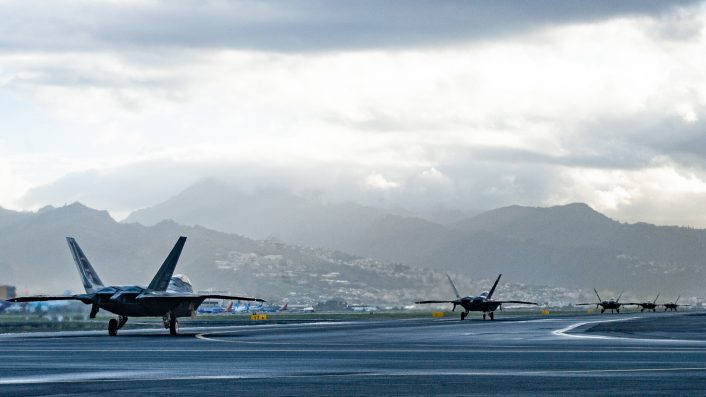
This was achieved through “an intense tempo, with participants generating back-to-back combat training sorties daily.” with “continuous exposure” of pilots to “varied threats, refining their decision-making, reaction times and overall combat effectiveness.” Joint maintenance teams, working on support and logistics, meanwhile launched, recovered, and maintained the diverse fleet of fifth-generation fighters, refueling tankers, and cargo aircraft, “ensuring a seamless flow of sorties and a full-spectrum air combat scenario.”
The exercise also underscores Hawaii’s “strategic location and training environment” in the Pacific, which might gain prominence in a high end war with China in the western Pacific.
“Hawaii offers great weather, especially over-water airspace to train in the Indo-Pacific Theater, as well as the opportunities to practice those agile combat employment tactics, techniques, and procedures,” said Lt. Col. Matthew Ohman, Sentry Aloha’s senior director with the 201st Combat Operations Squadron. “The Hawaiian Raptors rely heavily on these exercises to accomplish mission readiness – it’s a culmination of a lot of training.”
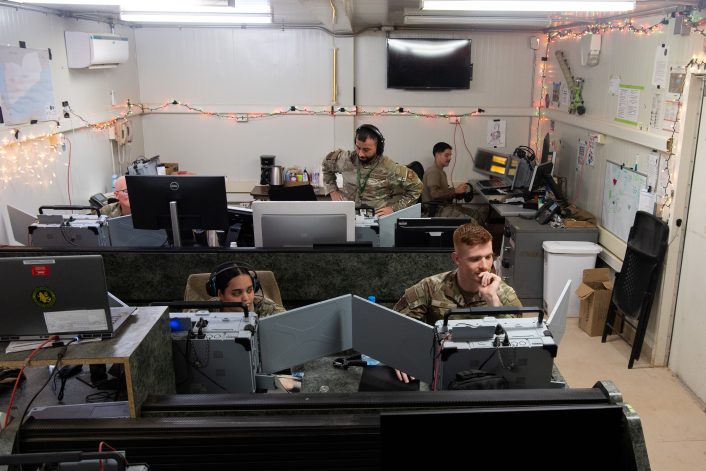
Double use tankers
Sentry Aloha 25-1 saw the 169th Air Defense Squadron (ADS) providing for the first time a team of Battle Management Operators aboard the KC-135, delivering non-traditional tactical command and control to the forward edge. From aboard the KC-135, the operators relayed near real-time situational awareness which was provided to them via beyond line of sight communications by Battle Management Operators and Air Battle Managers on the ground utilizing a simulated Common Operational Picture.
“The HIANG must continue to integrate,” said U.S. Air Force Tech. Sgt. Kukila Carreira-Manin,169th ADS, weapons and tactics NCO-in-charge. “Every service member within USINDOPACOM has a significant responsibility to support each other from every aspect in every rank. Time is precious within this theater and every second counts building our relationships with one another.”
The daily tanker support served as a force-multiplier, enabling fighter aircraft to extend their range and mission duration without the need for frequent landings to base. The Battle Management Operators onboard the tanker allowed it to contribute even more to the (simulated) fight, going well beyond the mere refueling.

